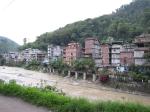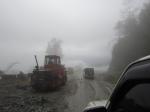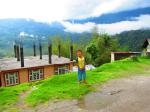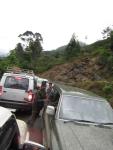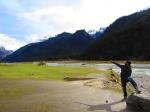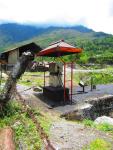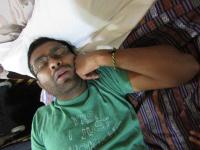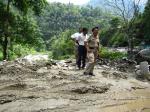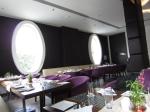Tag Archives: rabies
Darjeeling
Trip Facts:
- 5 nights
- Revolver Guesthouse
Hotel:
 For our 5 nights in Darjeeling we stayed at the Revolver Lodge. The lodge is located in a very good spot and very close to almost everything you need. This gem is managed by a wonderful family, Asenla and Vikash, husband and wife, and brother Sailesh. Their team tended to our every need, treated us like family, and even greeted us with hot Darjeeling tea upon our arrival (yum!). Revolver is themed after the Beatles’ seventh studio album and their memorabilia has been expertly selected and placed all over the facility. We splashed out and stayed in their very best room, named the John Lennon room, but we found Revolver to be an amazing deal at 900Rs/night (~$20USD)
For our 5 nights in Darjeeling we stayed at the Revolver Lodge. The lodge is located in a very good spot and very close to almost everything you need. This gem is managed by a wonderful family, Asenla and Vikash, husband and wife, and brother Sailesh. Their team tended to our every need, treated us like family, and even greeted us with hot Darjeeling tea upon our arrival (yum!). Revolver is themed after the Beatles’ seventh studio album and their memorabilia has been expertly selected and placed all over the facility. We splashed out and stayed in their very best room, named the John Lennon room, but we found Revolver to be an amazing deal at 900Rs/night (~$20USD)
People and Culture:
Most of the people of Darjeeling are very friendly in nature, and some of the nicest we’ve encountered in our travels through India; very mild-mannered and incredibly respectful. The culture is very strong here.
 Looking at the locals it is easy to see the different backgrounds which make up the community of Darjeeling. The local population is comprised of Nepalese and Tibetan migrants, as well as Sikkimese and Indian people. Walking down the street we began noticing that the different individuals seemed to be with mates from similar backgrounds, in other words we did not see any mixing of races. Even amongst the high-school age youth, the males and females holding hands seemed to be of the same race.
Looking at the locals it is easy to see the different backgrounds which make up the community of Darjeeling. The local population is comprised of Nepalese and Tibetan migrants, as well as Sikkimese and Indian people. Walking down the street we began noticing that the different individuals seemed to be with mates from similar backgrounds, in other words we did not see any mixing of races. Even amongst the high-school age youth, the males and females holding hands seemed to be of the same race.
While preparing our itinerary we learned the possible risks of traveling to Darjeeling include a Gorkha rally or protest, in which case all businesses are closed and some minor violence can ensue. Such protests occur for the sake of demonstration and not violence. However,just before our time in Darjeeling a newly elected official was supposedly shot and later died, which sparked the Gorkha protests closing all businesses for 1.5 days during our trip. We weren’t really impacted that much other than being forced to eat meals at our lodge, since restaurants were closed.
 There is a local revolution taking place by the Gorkha people who claim the hills of Darjeeling is their land (its been going on since before the British East India Company arrived) and want to separate from India and turn it into Gorkhaland. Traveling in and around these parts, reading pro-Gorkha signs and proposed maps of the new territories, you will quickly learn that there is a large organized Gorkha effort to reclaim “their” land.
There is a local revolution taking place by the Gorkha people who claim the hills of Darjeeling is their land (its been going on since before the British East India Company arrived) and want to separate from India and turn it into Gorkhaland. Traveling in and around these parts, reading pro-Gorkha signs and proposed maps of the new territories, you will quickly learn that there is a large organized Gorkha effort to reclaim “their” land.
The development of Darjeeling dates back to the mid-19th century, when the British set up a sanatorium and a military depot. It was a member of the British army who planted the first Chinese tea seeds in Darjeeling. Tea plantations have taken over the region since the land became famous for yielding the what some say is the world’s best tea.
Views and Weather:
 One of the things we all do when we take in an incredible view is to take in a deep breath in awe. For us, the smell of the tea gardens while taking in the views was extra nice because the smell added another dimension to the experience.
One of the things we all do when we take in an incredible view is to take in a deep breath in awe. For us, the smell of the tea gardens while taking in the views was extra nice because the smell added another dimension to the experience.
The views of Darjeeling, when the clouds eased up, were amazing. 6,700 feet up in the sky, colorful buildings built into very steep mountains with rows of bright green tea gardens twisting around and hugging the mountainsides. Some of the best views can be seen from the Hot Stimulating Café. The sun would peek through the clouds and light up and magnify the town so we could see each colorful building. The vibrant light to dark floral greens reminded us of the tea gardens everywhere.
The views from Darjeeling give a glimpse of much higher mountains like the 3rd highest in the world, Mt. Kanchenjunga, which we caught a small peek of. It feels magical and weird at the same time knowing that what you are staring at is at an altitude of over 28,000 feet. Since you are in the Himalayas, you basically see layers of rows of some of the tallest snow-capped mountain ranges in the world. Our visit to Darjeeling marked the beginning of seeing the Kanchenjunga range that we would progressively get closer to over the upcoming couple of weeks as we headed North.
Food:
A popular food in Darjeeling is the Tibetan momo, a steamed or fried dumpling filled with vegetables or meat and served with clear soup and/or achar. Various Tibetan noodle dishes are also very common, thukpa being a popular one. Other common dishes include potato-based sabjis, like alu-dum, greens picked locally and cooked with light spices, and lightly spiced daal, served with roti. Little to no oil is used in the  cooking process but ghee is served with the meal instead (mmm… ghee!).
cooking process but ghee is served with the meal instead (mmm… ghee!).
Tea is the locals’ beverage of choice. They are not too picky about brand or which tea estate the tea comes from but they do like it to be from a local source. Tea connoisseurs consider adding milk or sugar to delicate Darjeeling tea to be a crime, and believe that good tea requires neither. We’re both guilty as charged.
Tea Estate:
We visited the Happy Valley Tea Estate to answer the question, “where does tea come from”? The hike took about an hour, although it felt like two hours on that particularly hot day. The roads to get there were very windy and situated among steep hills. To take the factory tour we were given an option to go with an English or Hindi speaking guide. We opted for the English speaking guide, although it was very difficult to understand him (I later filled in the gaps with some research). We took a 20 minute “free” tour around the facility which allowed us to see where the magic happens. Since our research told us we would be asked for a tip, we were happy to give our tour guide the customary 20Rs ($.50). The Happy Valley Tea Estate exclusively exports their teas to Harrods of London, Germany, and Japan.
 HOW TEA IS MADE: In Darjeeling, women pick the tea leaves, and men work in the factory. Once the leaves are picked they are brought to the factory where the leaves are laid out on 100’ long drying belts where air is directed to help aid in the drying process. The moisture content needs to be reduced by 30% to make the tea leaf supple which takes up to 24 hours. Then the tea leaves get rolled, forcing the skin of the leaf to burst, allowing cell juice to mix with the oxygen. Germination begins and depending on the type of tea, germination time can vary, longer germination=stronger tea, but Darjeeling tea is known for its delicate flavor, not its strength. Next, the tea leaves get dried some more to complete the germination process. Then the leaves get sorted into different classes or categories such as whole leaf, broken, fannings and dust. The final step is to pack the tea so it can be shipped all over the world.
HOW TEA IS MADE: In Darjeeling, women pick the tea leaves, and men work in the factory. Once the leaves are picked they are brought to the factory where the leaves are laid out on 100’ long drying belts where air is directed to help aid in the drying process. The moisture content needs to be reduced by 30% to make the tea leaf supple which takes up to 24 hours. Then the tea leaves get rolled, forcing the skin of the leaf to burst, allowing cell juice to mix with the oxygen. Germination begins and depending on the type of tea, germination time can vary, longer germination=stronger tea, but Darjeeling tea is known for its delicate flavor, not its strength. Next, the tea leaves get dried some more to complete the germination process. Then the leaves get sorted into different classes or categories such as whole leaf, broken, fannings and dust. The final step is to pack the tea so it can be shipped all over the world.
Zoo:
 The Himalayan Zoological Park/Zoo appealed to us for the sole purpose that T got to see his favorite animal, the snow leopard, in person. Success! Other animals at the zoo include a variety of pheasants, parrots, peacocks, musk deer, tiger, bear, and the endangered red panda. The zoo is very easy to walk and didn’t take us more than 1.5 hours since we were moving fast.
The Himalayan Zoological Park/Zoo appealed to us for the sole purpose that T got to see his favorite animal, the snow leopard, in person. Success! Other animals at the zoo include a variety of pheasants, parrots, peacocks, musk deer, tiger, bear, and the endangered red panda. The zoo is very easy to walk and didn’t take us more than 1.5 hours since we were moving fast.
Hot Stimulating Café:
 The “Hot Stimulating Café” is our favorite place in Darjeeling to have tea and momos while catching views of the Himalayas, as well as Darjeeling town. Rambubhai (AKA Rambo) and his wife Lily own and run the café. She is a sweet soft-spoken woman who can be seen making momos and tea for the patrons while Rambo is out on treks or at the Buddhist monastery. Rambo is a hippy at heart with a warm helping nature. He has even dedicated a wall to Bob Marley, where you will find pasted newspaper and magazine cutouts. One can easily see Rambo and Lily’s love for peace loving philosophy upon entering their café.
The “Hot Stimulating Café” is our favorite place in Darjeeling to have tea and momos while catching views of the Himalayas, as well as Darjeeling town. Rambubhai (AKA Rambo) and his wife Lily own and run the café. She is a sweet soft-spoken woman who can be seen making momos and tea for the patrons while Rambo is out on treks or at the Buddhist monastery. Rambo is a hippy at heart with a warm helping nature. He has even dedicated a wall to Bob Marley, where you will find pasted newspaper and magazine cutouts. One can easily see Rambo and Lily’s love for peace loving philosophy upon entering their café.
We became friends with Rambo and we asked him to take us to where the locals hang out. We ended up going to an underground speakeasy to have some drinks with the locals. We spent a couple hours there and met some really easygoing folks who shared some great stories with us about their lives and work. The owner of the speakeasy also made fresh sausages, although we didn’t try any. We ended up visiting an off the beaten path restaurant with our new friends. We had some great conversations about globalization and politics.
Horse bite:
 As we walked from the speakeasy to the restaurant, we walked past the indoor/outdoor stable where the ponies (used for local pony-rides around Darjeeling) live. Jyoti eyeballed a pony and decided she was going to pet it. As she approached the white pony with her hand, the pony lunged its head forward and bit her on the arm, leaving her in pain. Jyoti complained for a bit but shook it off as we continued our way to the restaurant.
As we walked from the speakeasy to the restaurant, we walked past the indoor/outdoor stable where the ponies (used for local pony-rides around Darjeeling) live. Jyoti eyeballed a pony and decided she was going to pet it. As she approached the white pony with her hand, the pony lunged its head forward and bit her on the arm, leaving her in pain. Jyoti complained for a bit but shook it off as we continued our way to the restaurant.
 The next morning we both woke up to signs of a pretty bad bruise on Jyoti’s arm with teeth marks, but no skin was penetrated or blood drawn. While eating breakfast in the lodge’s restaurant, a person by the name of Samuel Thomas overheard our conversation of how Jyoti was bitten by a horse and recommended a doctor, because after being bitten by an animal, Jyoti was at risk for rabies. I started researching rabies and got freaked out because there is no cure for rabies. If you are bitten, you need to get a series of 5 rabies vaccinations over 30 days to make you immune, or if you don’t and the animal had rabies – you will become fatally ill and die. We decided Jyoti was going to have to get the shot since there was no way to confirm if the horse was rabid (it takes 7 days before the horse would have died from it and we would have been gone by then).
The next morning we both woke up to signs of a pretty bad bruise on Jyoti’s arm with teeth marks, but no skin was penetrated or blood drawn. While eating breakfast in the lodge’s restaurant, a person by the name of Samuel Thomas overheard our conversation of how Jyoti was bitten by a horse and recommended a doctor, because after being bitten by an animal, Jyoti was at risk for rabies. I started researching rabies and got freaked out because there is no cure for rabies. If you are bitten, you need to get a series of 5 rabies vaccinations over 30 days to make you immune, or if you don’t and the animal had rabies – you will become fatally ill and die. We decided Jyoti was going to have to get the shot since there was no way to confirm if the horse was rabid (it takes 7 days before the horse would have died from it and we would have been gone by then).
After seeing the doctor, we went to the pharmacy to buy the shot and then back to the hospital to have a sister (nurse) administer it to Jyoti. Locating, purchasing, and finding someone to administer the next four shots would later become four little adventures. Stay-tuned for Gangtok, Pelling, Gujarat, and Istanbul.
Jyoti got bitten by a horse!
We started our day by visiting the Happy Valley Tea Estate (which only exports their tea to Harrods of London, Japan, and Germany),we then visited the zoological center and saw a snow leopard. Later, we hung out with the owners of the “Hot Stimulating Cafe,” Lily and Rambubhai (aka Rambo). We had some nimbu nu serbert (sweet lime water) and masala chai. At 5 or 6pm we went to have some drinks with Rambo at a local underground speakeasy with a view of the North Himalayas. We met more cool local people and sampled local beers and some amazing gin from Sikim called Big Ben. On our way to grab dinner we passed a pony house where Jyoti tried to pet a horse and got bitten!
This morning when we woke up we decided that it be best for us to visit the doctor and have the minor wound checked out with rabies being our main concern. We have an appointment in 30 minutes. All should be fine!
As for the horse, I’m gonna go give it a piece of my mind after Jyoti gets checked out. I’ll snap a picture of the horse and poor lil Jyoti’s wound and post it on here later.



